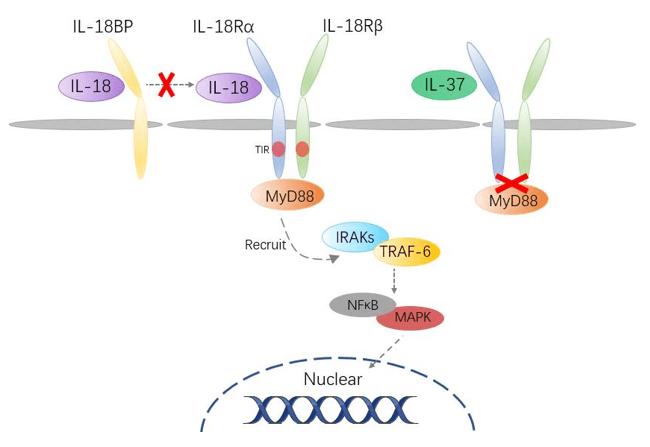Introduction
Interleukin-18 (IL-18) also known as interferon-gamma inducing factor. It belongs to the IL-1 superfamily and is produced mainly by macrophages but also other cell types, stimulates various cell types and has pleiotropic functions. IL-18 is similar to IL-1β for being processed by caspase 1 to an 18 kD biologically active mature form. IL-18 is able to induce severe inflammatory reactions, which suggests its role in certain inflammatory disorders. And there is evidence for a role of IL-18 in various infectious, metabolic or inflammatory diseases such as influenza virus infection, atheroma, myocardial infarction, chronic obstructive pulmonary disease.
Mechanism and Function
IL-18 forms a signaling complex by binding to the IL-18 alpha chain (IL 18Rα), which is the ligand binding chain for mature IL-18; however, this binding is of low affinity (Figure 1).In cells that express the co-receptor, termed IL-18 receptor beta chain (IL-18Rβ), a high affinity complex is formed, which then signals.The complex of IL-18 with the IL-18Ra and IL-18Rβ chains is similar to that formed by other members of the IL-1 family with the co-receptor, the IL-1R accessory chain IL-1RAcP (also termed IL-1R3). Although nearly all cells express the IL-1R1, not all cells express IL-1RAcP. Similarly, most cells express the IL-18Ra but not all cells express the IL-18Rβ. IL-18Rβ is expressed on T-cells and dendritic cells but not commonly expressed in mesenchymal cells. Following the formation of the heterodimer, the Toll-L-1 receptor (TIR) domains approximate and it appears that the cascade of sequential recruitment of MyD88, the IRAKs and TRAF-6 followed by the degradation of IκB and release of NFκB are nearly identical as that for IL-1.
The activity of IL-18 can be suppressed by extracellular interleukin 18 binding protein (IL-18BP) that binds soluble IL-18 with a higher affinity than IL-18Rα thus prevents IL-18 binding to IL-18 receptor. IL-37 is another endogenous factor that suppresses the action of IL-18. IL-37 has high homology with IL-18 and can bind to IL-18Rα, which then forms a complex with IL-18BP, thereby reduces the activity of IL-18.
With the deepening of research, it has been found that IL-18 can act on different cells. It can promote the inflammatory response process, stimulate the formation of blood vessels, promote mitosis, and regulate the immune function of the host. The occurrence and development of sexually transmitted diseases are closely related.
 Fig 1. Mechanism of Signaling
Fig 1. Mechanism of Signaling
Creative Proteomics can provide cytokine detection platform for scientific research. According to different purposes, our dedicated analysts will customize exclusive solutions for you. We aim to provide customers with high-quality and convenient services to help you accelerate the progress of your project.
Our cytokine detection service includes but is not limited to:
- Single cytokine qualitative and quantitative detection
- Multiple cytokines qualitative and quantitative detection
- Cytokines qualitative and quantitative detection of multiple species
- Cytokine antibodies qualitative and quantitative detection
Sample requirements
- Sample Types-Blood, serum, plasma, cell culture supernatant, cell lysate, cell culture medium, tissue homogenate, urine, tumor, etc.
- Sample Volume - It is optimal for at least 200µl of each sample. This volume allows for triplicate testing of each sample.
Our advantages:
- A variety of detection methods are available, which can be selected according to different samples and requirements.
- High-quality antibodies are used in the detection process to improve detection specificity and accuracy.
- Repeat testing to ensure repeatability and accuracy of experimental results.
- The feedback results are professional and efficient.
Technology platform:
We mainly provide the Luminex cytokine detection platform. Luminex uses fluorescently encoded microspheres with specific antibodies to different target molecules. The different microspheres can be combined freely to a certain extent so that up to 100 analytes can be tested multiple times simultaneously in a single experiment.
The Luminex cytokine assay platform has the following advantages:
- Multiple detection: simultaneous detection of 100 biological targets
- Short experiment time: 1-3 weeks
- High sensitivity: the lower limit of accurate quantification is as low as 0.1 pg/mL
- Save samples: only need a sample volume as low as 25 μL
- Time saving: the experiment process only takes 4 hours
For your different needs, we can also provide the following detection methods:
- Enzyme-linked immunosorbent assay (ELISA)
- Flow cytometry
Workflow

For more information about the IL-18 detection service or need other detection requirements, please contact us.
Reference:
- Murray K N, et al. Interleukin-18: Biological properties and role in disease pathogenesis. Immunological Reviews, 281(1):138–153.



